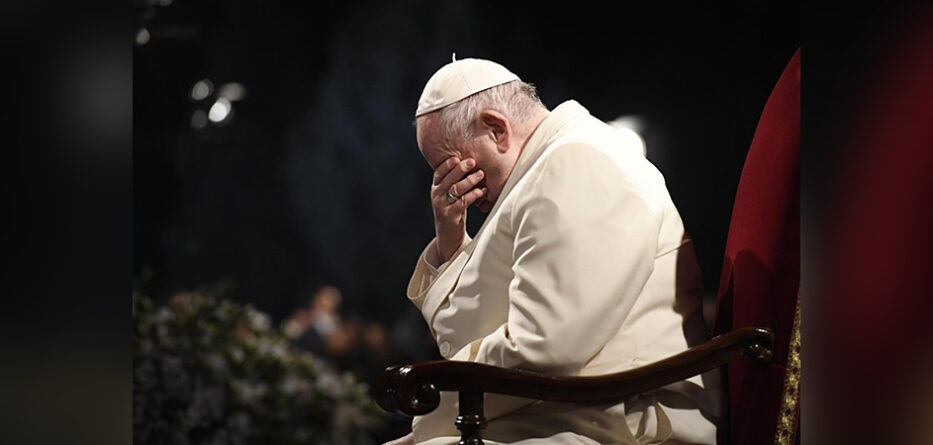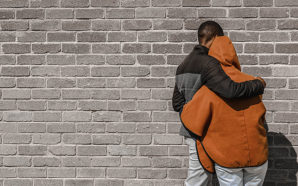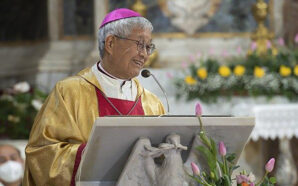Annual liturgical marathon will test the stamina of the ageing and ailing pope, whose mobility is severely limited and whose speech has been reduced at times to a whisper.
Christ did not come down from the cross. That was John Paul II’s response when people started wondering loudly in the corridors of the Vatican and in the pages of the world’s newspapers whether he would resign from the papacy.
It was the beginning of 2005 and the Polish pope was well into his 85th year of life. Almost completely crippled by Parkinson’s at this point, he could barely speak more than a few words at a time that were comprehensible. The long-reigning Roman Pontiff had already begun his own Calvary when Palm Sunday arrived. It was March 20 and, for the first time in his more than 26 years on the Chair of Peter, he did not preside at the opening of Holy Week or any of the other liturgies that led up to Easter. John Paul was still recovering from throat surgery after one of his numerous hospitalizations and could not even attend the Palm Sunday Mass.
Yet he still wanted to greet the crowds that had gathered for the outdoor liturgy and Angelus that followed it. When his aides propped him up at his study window overlooking St. Peter’s Square, however, his mouth froze and he could not produce any words. In frustration, the pope angrily banged his hand on the lectern, his head bobbing above his bent frame.
It was a difficult and sad moment to witness. Then, two weeks later, he was dead.
A slower and more enfeebled Pope Francis
Palm Sunday is now here again, and we have another enfeebled pope who is determined to usher the Church into Holy Week. The good news is that this year’s liturgical marathon leading to Easter is not going to be like the one that took place 19 years ago at the Vatican. At least we hope not. Pope Francis does not appear to be dying, as the now-sainted John Paul very clearly was — despite the “inventive” health reports to the contrary that Joaquín Navarro-Valls, the Polish pope’s trusted spokesman and spin-doctor, was issuing each day.
But there is also some bad (or, at least, not-so-good) news: Francis is likely to play a much more limited role than he has at any of the other Holy Week and Easter celebrations he’s presided over since his 2013 election to the See of Rome. That’s because he, too, is being slowed by age; he’s now more than two years older than John Paul was when he died. And he is also hampered by severely decreased mobility, and — more recently — difficulties in speaking.
The Vatican’s communications officials (there is no longer anything like a papal spokesman these days) are slightly more transparent than Navarro ever was. And, thank goodness, they are not trying to imitate the late Spaniard’s impressive and legendary capacity to be “creative” with the truth.
Indeed, the staff at the Holy See Press Office and the Dicastery for Communication, in general, seem to be doing their level best to help us all understand the current state of Francis’ health. But they can only convey what the Jesuit pope conveys to them. And that is not always very much.
Whether it is by instructions from on high or not, it is interesting to note that camera crews of the official Vatican Media have begun turning their lenses towards the crowds, the dome of St. Peter’s Basilica or birds flying in the air whenever Francis tries to negotiate a few steps or when he moves in and out of his wheelchair.
And the wheelchair is only one of the things that have slowed the world’s first pope from the New World. The other age- and health-related issues that have already been mentioned will make this a very challenging Holy Week for him. Francis seems to have now begun a new and more physically difficult stage of his pontificate. The way he is able (or not able) to navigate the ceremonies over the next several days may determine how he continues on in this new stage, especially regarding his desire to keep travelling abroad.
New limits on the pope’s words and gestures
The Office of Papal Liturgies issued the schedule for Holy Week and Easter several days ago. It lists eight different ceremonies, all of which the pope is slated to “preside” over. That word can be a bit misleading. Francis has not actually stood at the altar during Mass in more than a year, except some months ago at a smaller celebration at a Rome cemetery. And even there he was the co-presider. It has become standard for him to “preside” at Mass from a chair off to the side of the altar. He usually does not wear a chasuble, but a cope and a stole. Recently, he has been having greater difficulty standing for even short periods of time, even if he sometimes attempts to walk, taking only small and slow steps over short distances.
Francis is scheduled to give four or five homilies during Holy Week, as well as deliver the “Urbi et Orbi” address to the city and the world on Easter Sunday. He is supposed to preach at the Palm Sunday liturgy, the Chrism Mass on Thursday morning, and the Easter Vigil. He is also expected to give a brief, unscripted homily at the Mass of the Lord’s Supper on Thursday, which will take place in the women’s section of a prison on the outskirts of Rome.
Unless he has an aide read the homilies at the major ceremonies, these texts will likely be very brief. For the past several weeks, Francis has had aides read his addresses for him — including at his weekly general audience. Just about the only ones he reads himself these days are the Angelus reflections, which are much briefer.
And what about the foot-washing ritual at Mass of the Lord’s Supper? It has always been Francis’ practice to commemorate Jesus’ act of washing the feet of his disciples by washing the feet of the prisoner. Will he be able to do so this year? His mobility is so limited now that it seems the only way that can happen is by designing new logistics, such as remaining in his wheelchair rather than kneeling down as he’s usually done. And during the Commemoration of the Passion on the afternoon of Good Friday, there is a moment when the pope is to lie prostrate on the floor. If he does so this year, he will likely need three or four people to help him get down and stand up again.
Mixed signals about a possible resignation
Once again, like back in 2005, people are starting to wonder if the current will at some point decide it’s time to retire. Will he refuse to “come down from the cross”, as John Paul II did? Or will do as Benedict XVI and eventually resign?
From the very beginning of his pontificate, Francis has given mixed signals on the issue. Most recently, in his new autobiography, he seemed to say he’s not even thinking of resigning. For now. And he’s always insisted that he doesn’t govern the Church with his knees or legs, but with his head. However, the mouth is connected to the head and the mouth (and lungs) are an extremely — many would argue, essential — part of being Bishop of Rome. What happens when the speaking ability of the Chief Pastor of the Universal Church is severely hampered?
Francis is not at that point. And he may never get there. But the physical decline is beginning to take a serious toll on him and that may force him to adjust, even if reluctantly, the way he’s carried out the Petrine Ministry up until now. His own “Via Crucis” may have already begun.
Reproduced with permission from La Croix International.








